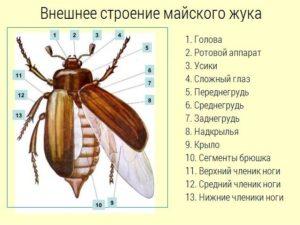What does the cockchafer and its larva look like: a voracious couple
In May, it is very common to see the cockchafer or cockchafer. The name is associated with the appearance and beginning of active life in May. The insect is one of the most common pests of horticultural and horticultural crops.
Content
Maybug: photo
Description of the Maybug
Name: Maybugs or cockchafers
Latin: MelolonthaClass: Insects - Insecta
Squad: Coleoptera - Coleoptera
Family: Lamellar - Scarabaeidae
 | Habitats: | forests, forest-steppes |
 | Dangerous for: | young leaves, plant roots |
 | Means of destruction: | manual collection, prevention, chemicals |
Size Maybug varies from 17,5 to 31,5 mm. The body has an elongated oval shape. The color is black or red-brown. There is a chitinous shell on the body.
Elytra contribute to the protection of the hind wings and the dorsal side of the belly of the insect. The elytra are reddish-brown or yellowish-brown in color. The small head is drawn into them. The head is dark greenish in color.
Habitat
Habitat - Europe, Asia Minor, USA, India, Japan, China, Tibet. The Palearctic zone is very rich in these beetles. The Russian Federation and the CIS countries have 9 varieties.
May beetles prefer river valleys and areas adjacent to forests. In loose sandy or sandy loamy soil, they are most comfortable.
Varieties of May beetles
In total, there are 63 species of insect. But there are some of the most popular varieties.
Life cycle
The maximum life expectancy of the May Khrushchev is 5 years. Mating begins in late May - early June. After the end of this process, the female hides in the ground and lays eggs.
The clutch contains up to 30 eggs. After that, the female feeds intensively. There is another mating followed by laying. The maximum number of clutches can be 4. Sometimes the number of eggs can be 70. The eggs are gray-white in color. Diameter within 1,5-2,5 mm.
A month later, larvae appear. They have a thick, curved, white body and 3 pairs of limbs. The head is yellow or with a brick tint. The body is covered with sparse hairs. Within 3 years, the larvae form and grow in the soil. The larvae hibernate at a depth of about 1,5 m. With the advent of heat, they move to the upper layer of the earth.
In the first summer of life, the larva eats humus and tender grass roots, and in the second year it feeds on thick plant roots. In the third year, pupation begins in summer. The size of the pupa is 2,5 cm. This period takes from a month to a month and a half. After that, a beetle appears.
The departure of beetles in the eastern regions falls at the end of April, in the western regions - at the beginning of May. The eastern variety is selected from the shelter 1,5 - 2 weeks earlier than the western ones. The females fly out a week later.
May beetle diet
The diet of adult representatives consists of young shoots, leaves, flowers, ovaries of wild and cultivated shrubs and trees. They eat:
- apple trees;
- cherry;
- cherry;
- plum;
- sea buckthorn;
- gooseberry;
- blackcurrant;
- maple;
- oak;
- mountain ash;
- poplar;
- birch;
- chestnut;
- willow;
- aspen;
- hazel;
- beech;
- linden.
preventive measures
The movement of the beetle around the site is completely impossible to prevent. Also, sometimes prevention does not bring the proper benefit, because the larvae are in the soil for a long time. To try to reduce or prevent the appearance of pests, you must:
- in the fall, dig up the soil, adding whiteness or bleach;
- in the spring, water the beds with water and ammonia;
- plant white creeping clover near fruit crops to accumulate nitrogen;
- in the spring, add chicken shells to the ground;
- in the spring, place birdhouses to attract birds;
- plant elderberry, cabbage, turnip - they repel the smell of parasites.
Methods of dealing with the May beetle
May beetles have enemies in nature. Bats, rooks, starlings feed on larvae. Hedgehogs, moles and badgers hunt for adults.
In the areas you need to independently deal with larvae and adults.
Chemicals
Preparations with a dangerous composition are used strictly according to the instructions, so as not to harm the plantings. Of the chemicals, it is worth noting the excellent result of using several drugs:
- Bazudin;
- Antikhrushch;
- Zemlin;
- Nembakt.
Folk remedies
One of the easiest ways to remove a beetle is to dig up the area and manually select the larvae. This can significantly reduce the population. From folk remedies, gardeners recommend watering the beds:
- decoction of onion husks (100 gr) in 5 liters of water.
- decoction of garlic (100g) with 5 liters of water;
- a mixture of potassium permanganate (5 g) with 1 liter of water.
Interesting facts about the May Khrushchev
A few facts about the Maybug:
- the insect is able to fly, although it does not have enough lift coefficient - scientists believe that flight with such indicators is impossible;
- the beetle is distinguished by purposefulness - it moves towards its goal, not paying attention to obstacles;
- thanks to their extraordinary appetite, the larvae can eat pine roots in 24 hours.
Conclusion
The Maybug is capable of causing enormous damage in gardens and orchards. Be sure to carry out prevention to prevent the invasion of unwanted neighbors. When pests appear, choose any of the methods of control.
Previous
